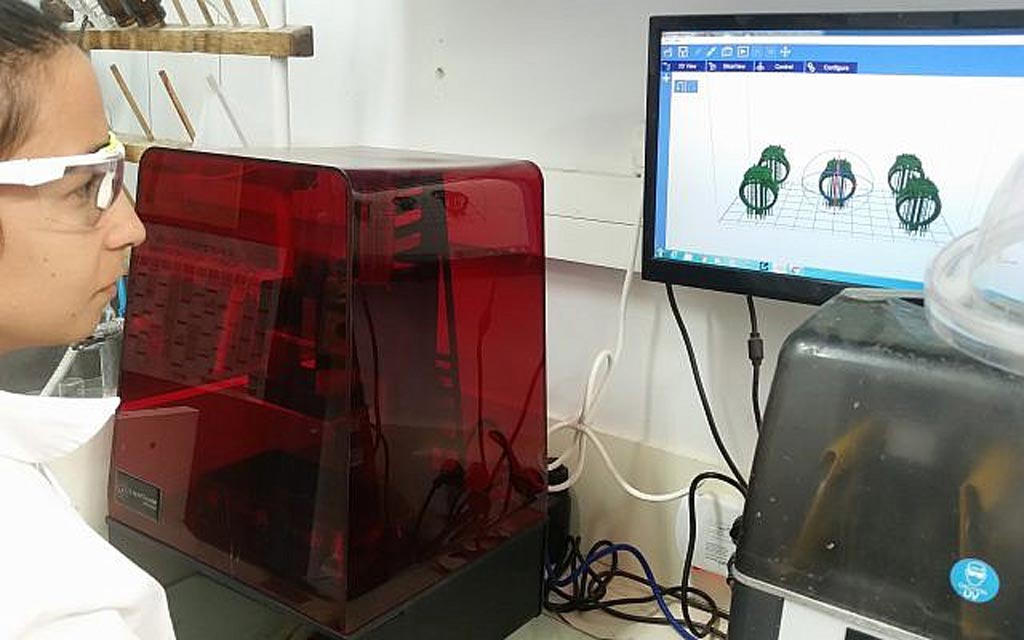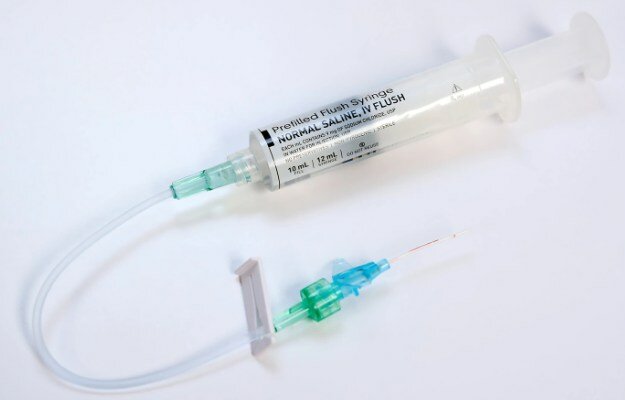New Platform Prints Customized 3D Pharmaceuticals
|
By HospiMedica International staff writers Posted on 20 Nov 2018 |

Image: A 3D printer in the lab of Professor Shlomo Magdassi (Photo courtesy of Hebrew University).
A novel technology platform uses three-dimensional (3D) printing to create custom drug capsules made of hydrogels with delayed release characteristics.
The new technology, developed at the Hebrew University (HUJI; Jerusalem, Israel), is designed to facilitate 3D printing of personalized medications out of hydrogels that can expand, change shape, and activate on a delayed schedule. By fine-tuning the drug capsules geometry, surface area, and swelling index, improved targeting of the site of drug release in the digestive tract is possible, as well as greater control of drug-release timing and duration.
The oral dosage forms of the pH responsive hydrogels were 3D printed using monomer acrylic acid, a polyethylene (glycol) diacrylate (PEGDA) cross-linker, and a thyroperoxidase (TPO) photoinitiator. The technology is based on photo-polymerization of photo-reactive compositions within a bath filled with a polymerizable ink, usually by ultraviolet (UV) digital light processing (DLP), which allows high resolution, complex structures, low printing cost, and large build size.
The printed structures can release drugs at a higher pH, enhancing drug absorption in the intestine. According to the researchers, the flexibility in design and manufacturing of the structures, the large surface area possible, and the complex geometries can be utilized for personalized, programmable delivery systems, with a variety of materials and functional properties that cannot be fabricated by conventional pharmaceutical manufacturing methods. The technology was presented at the 3D Printing and Beyond 2nd annual conference, held during November 2018 in Jerusalem (Israel).
“The custom-printed pills are made out of a hydrogel in which the medication is inserted. The substance has the consistency of malabi, a Middle Eastern milk pudding,” said Professor Shlomo Magdassi, PhD, head of the Hebrew University’s 3D and Functional Printing Center. “The technology enables the creation of pills with complex designs, from star-shaped to crystalline to round, that can expand, change shape and be activated on a preset schedule. This is currently not possible, or very expensive to do, in conventional pharmaceutical manufacturing techniques.”
“The flexibility enables the capsules to expand or release their medication at the location they need to target. For example, a tablet can be printed that can swell in the stomach to give a feeling of fullness, or to only release its medication in the intestine, where acidity is lower than in the stomach,” concluded Professor Magdassi. “These 3D printed objects will be able to change shape through contact with water, or humidity – enabling them to open only under certain conditions. It will also allow doctors to more specifically tailor the dosage of the drugs to individual patients.”
Related Links:
Hebrew University
The new technology, developed at the Hebrew University (HUJI; Jerusalem, Israel), is designed to facilitate 3D printing of personalized medications out of hydrogels that can expand, change shape, and activate on a delayed schedule. By fine-tuning the drug capsules geometry, surface area, and swelling index, improved targeting of the site of drug release in the digestive tract is possible, as well as greater control of drug-release timing and duration.
The oral dosage forms of the pH responsive hydrogels were 3D printed using monomer acrylic acid, a polyethylene (glycol) diacrylate (PEGDA) cross-linker, and a thyroperoxidase (TPO) photoinitiator. The technology is based on photo-polymerization of photo-reactive compositions within a bath filled with a polymerizable ink, usually by ultraviolet (UV) digital light processing (DLP), which allows high resolution, complex structures, low printing cost, and large build size.
The printed structures can release drugs at a higher pH, enhancing drug absorption in the intestine. According to the researchers, the flexibility in design and manufacturing of the structures, the large surface area possible, and the complex geometries can be utilized for personalized, programmable delivery systems, with a variety of materials and functional properties that cannot be fabricated by conventional pharmaceutical manufacturing methods. The technology was presented at the 3D Printing and Beyond 2nd annual conference, held during November 2018 in Jerusalem (Israel).
“The custom-printed pills are made out of a hydrogel in which the medication is inserted. The substance has the consistency of malabi, a Middle Eastern milk pudding,” said Professor Shlomo Magdassi, PhD, head of the Hebrew University’s 3D and Functional Printing Center. “The technology enables the creation of pills with complex designs, from star-shaped to crystalline to round, that can expand, change shape and be activated on a preset schedule. This is currently not possible, or very expensive to do, in conventional pharmaceutical manufacturing techniques.”
“The flexibility enables the capsules to expand or release their medication at the location they need to target. For example, a tablet can be printed that can swell in the stomach to give a feeling of fullness, or to only release its medication in the intestine, where acidity is lower than in the stomach,” concluded Professor Magdassi. “These 3D printed objects will be able to change shape through contact with water, or humidity – enabling them to open only under certain conditions. It will also allow doctors to more specifically tailor the dosage of the drugs to individual patients.”
Related Links:
Hebrew University
Channels
Critical Care
view channel
Light-Based Technology to Measure Brain Blood Flow Could Diagnose Stroke and TBI
Monitoring blood flow in the brain is crucial for diagnosing and treating neurological conditions such as stroke, traumatic brain injury (TBI), and vascular dementia. However, current imaging methods like... Read more
AI Heart Attack Risk Assessment Tool Outperforms Existing Methods
For decades, doctors have relied on standardized scoring systems to assess patients with the most common type of heart attack—non-ST-elevation acute coronary syndrome (NSTE-ACS). The GRACE score, used... Read moreSurgical Techniques
view channel
Robotic Assistant Delivers Ultra-Precision Injections with Rapid Setup Times
Age-related macular degeneration (AMD) is a leading cause of blindness worldwide, affecting nearly 200 million people, a figure expected to rise to 280 million by 2040. Current treatment involves doctors... Read more
Minimally Invasive Endoscopic Surgery Improves Severe Stroke Outcomes
Intracerebral hemorrhage, a type of stroke caused by bleeding deep within the brain, remains one of the most challenging neurological emergencies to treat. Accounting for about 15% of all strokes, it carries... Read morePatient Care
view channel
Revolutionary Automatic IV-Line Flushing Device to Enhance Infusion Care
More than 80% of in-hospital patients receive intravenous (IV) therapy. Every dose of IV medicine delivered in a small volume (<250 mL) infusion bag should be followed by subsequent flushing to ensure... Read more
VR Training Tool Combats Contamination of Portable Medical Equipment
Healthcare-associated infections (HAIs) impact one in every 31 patients, cause nearly 100,000 deaths each year, and cost USD 28.4 billion in direct medical expenses. Notably, up to 75% of these infections... Read more
Portable Biosensor Platform to Reduce Hospital-Acquired Infections
Approximately 4 million patients in the European Union acquire healthcare-associated infections (HAIs) or nosocomial infections each year, with around 37,000 deaths directly resulting from these infections,... Read moreFirst-Of-Its-Kind Portable Germicidal Light Technology Disinfects High-Touch Clinical Surfaces in Seconds
Reducing healthcare-acquired infections (HAIs) remains a pressing issue within global healthcare systems. In the United States alone, 1.7 million patients contract HAIs annually, leading to approximately... Read moreBusiness
view channel
Philips and Masimo Partner to Advance Patient Monitoring Measurement Technologies
Royal Philips (Amsterdam, Netherlands) and Masimo (Irvine, California, USA) have renewed their multi-year strategic collaboration, combining Philips’ expertise in patient monitoring with Masimo’s noninvasive... Read more
B. Braun Acquires Digital Microsurgery Company True Digital Surgery
The high-end microsurgery market in neurosurgery, spine, and ENT is undergoing a significant transformation. Traditional analog microscopes are giving way to digital exoscopes, which provide improved visualization,... Read more
CMEF 2025 to Promote Holistic and High-Quality Development of Medical and Health Industry
The 92nd China International Medical Equipment Fair (CMEF 2025) Autumn Exhibition is scheduled to be held from September 26 to 29 at the China Import and Export Fair Complex (Canton Fair Complex) in Guangzhou.... Read more














